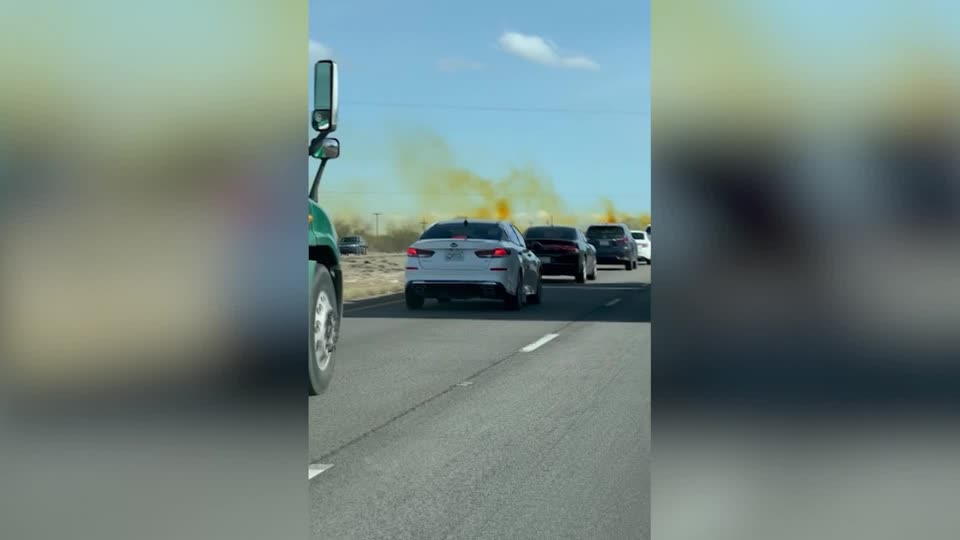
[elfsight_social_share_buttons id=”1″]
A tanker truck hauling nitric acid overturned on an interstate highway near Tucson, Arizona, on Tuesday, causing a leak of its highly toxic, volatile cargo in a fiery wreck that shut down the road for hours, authorities said.
The Arizona Department of Public Safety (ADPS) urged residents nearby to remain inside and said first responders were working to evacuate a perimeter around the incident “out of an abundance of caution.”
The crash took place around 2:43 local time according to the ADPS and video footage from the wreckage shows a plume of red smoke billowing from the overturned tanker. Residents said they could see the smoke from over 5 miles away.
Officials evacuated people that were located within a half-mile radius of the accident and ordered those within a mile to shelter in place. The shelter-in-place order was lifted at 8:45 pm and the evacuation order was to be lifted this morning.
It said state police anticipated an “extensive” closing of Interstate Highway 10 after the “injury collision,” which disrupted the major east-west traffic artery and truck route that crosses much of the U.S. Southwest.
The Tucson Fire Department said it was helping “control the hazmat and brush fire incidents” at the crash site. The extent of injuries and whether other vehicles were involved were not explained, nor was the accident’s cause or scope of the spill.
Nitric acid, used in the washing of glassware or metal equipment, is a highly corrosive chemical that can cause severe lung damage if inhaled and irritation on contact with the skin and eyes, according to the University of Washington.
The toxic spill comes 11 days after a Norfolk Southern freight train derailed in eastern Ohio, igniting a fire that sent a cloud of toxic fumes and smoke over the town of East Palestine and forced thousands of residents to evacuate.
OHIO TOXIN CONCERNS
Cleanup of the Ohio train that crashed 11 days ago is moving quickly, Ohio Governor Mike DeWine said on Tuesday, while residents and observers questioned the health impacts of pollution that spilled into the Ohio River.
The Norfolk Southern Railroad-operated train derailed on Feb. 3, causing a fire that sent a cloud of smoke over the town of East Palestine, Ohio, and forcing thousands of residents to evacuate. After railroad crews drained and burned off a toxic chemical from five tanker cars, DeWine on Feb. 8 said that residents could return to their homes.
While DeWine said the pollution did not pose a serious threat to five million people who rely on the river for drinking water, he and several Ohio health and environmental officials cautioned at an afternoon press conference that residents using private wells near the derailment should only use bottled water.
Reporters pressed DeWine and other officials about some residents’ complaints of headaches and concern that the government or the railroad were not telling them the entire truth about the pollution and potential harm.
One of the chemicals on the train was vinyl chloride, which the U.S. Environmental Protection Agency says is highly flammable and carcinogenic, especially through inhalation. When burned, it decomposes into other toxic compounds including hydrogen chloride.
Dr. Bruce Vanderhoff, director of the Ohio Department of Health, said the compounds spilled can cause headaches and eye and nose irritation even at levels considered safe, but that the “measured facts” show air sampling is not reporting any dangers.
The plume of pollution in the Ohio River is moving at one mile per hour toward the Mississippi River, nearing Huntington, West Virginia, on Tuesday afternoon, said Tiffany Kavalec, chief of the surface water division of the Ohio Environmental Protection Agency.
Cities in the plume’s path can turn off their drinking water intakes as it floats by, Kavalec said. Drinking water tests have not raised concerns and normal water treatment would remove any small amounts of contaminants that may exist, Kavalec said.
Officials are claiming that the volume of the river diluted the plume and it did not pose a serious threat. However, many are questioning the assessment as over 3,500 fish have already died in streams contaminated with toxins from the crash.
Railroad union officials said they have been warning that such an accident could happen because railroad cost-cutting harmed safety measures.
“No one wants to listen until we have a town blown off the face of the earth, then people listen,” said Clyde Whitaker, chairman for the largest U.S. railroad union representing conductors, engineers, and other workers.
DeWine said that he spoke with Norfolk Southern CEO Alan Shaw on Tuesday morning.
“I asked if he would personally guarantee that the railroad would stay there until absolutely everything was clean. He gave me his word and his commitment that the railroad would do that, they would not leave until that was done,” the governor said.
The federal Environmental Protection Agency (EPA) had earlier notified the company it may be liable for cleaning up under the U.S. Superfund law.
Local residents have sued Norfolk Southern for negligence and are demanding that the company monitor the health effects of those in the impact radius of the crash.
Attorney Brad Trust who represents the victims in the lawsuit said that the pollution from the spill and subsequent burn-off of chemicals is impacting residents far beyond the two-mile radius of the derailment, where most of the evacuations occurred. “Right now, we have clients with respiratory problems, problems with breathing,” he stated.
Copyright 2023 Thomson/Reuters. Additions and edits for FISM News by Michael Cardinal
